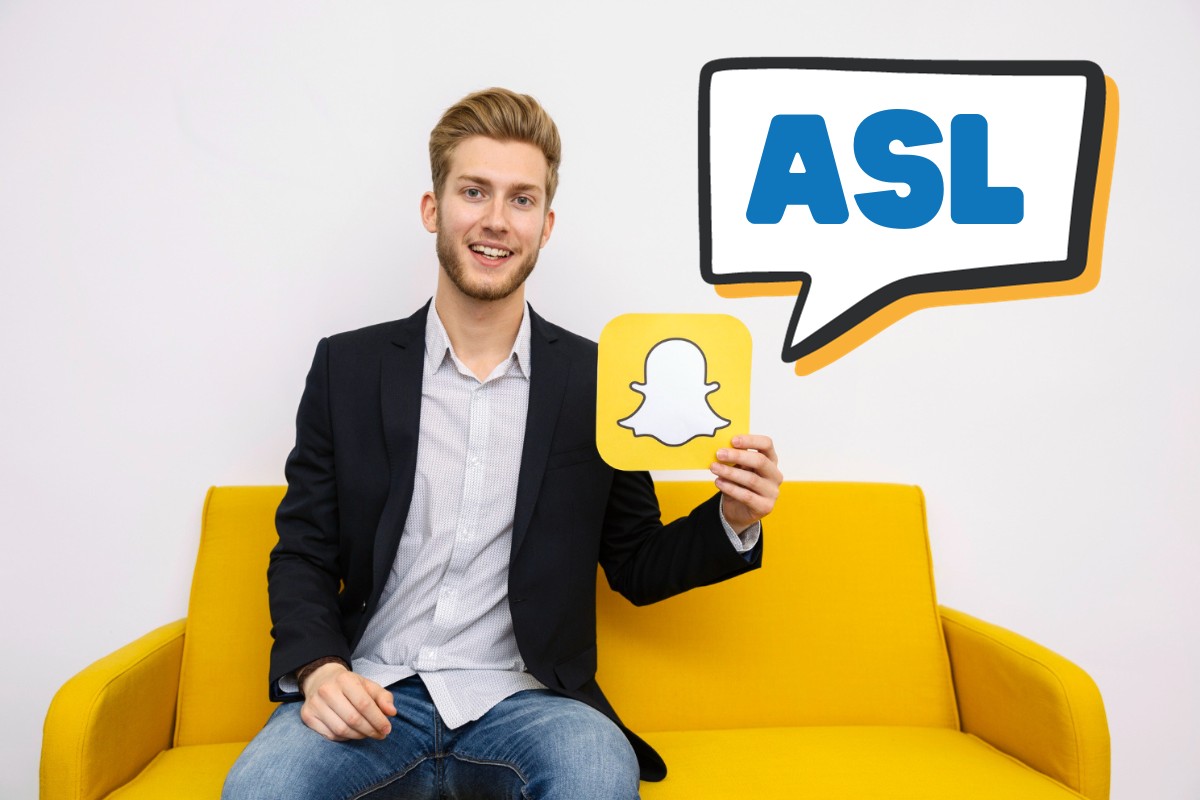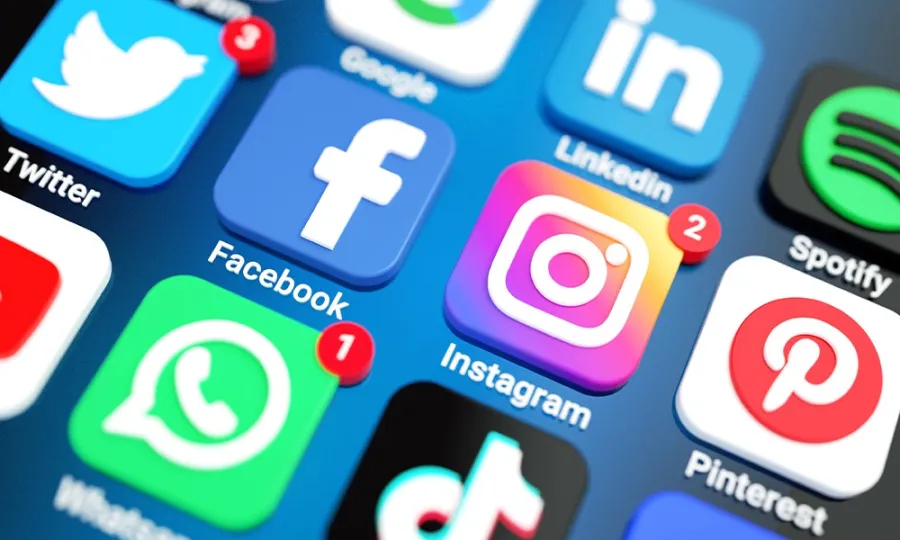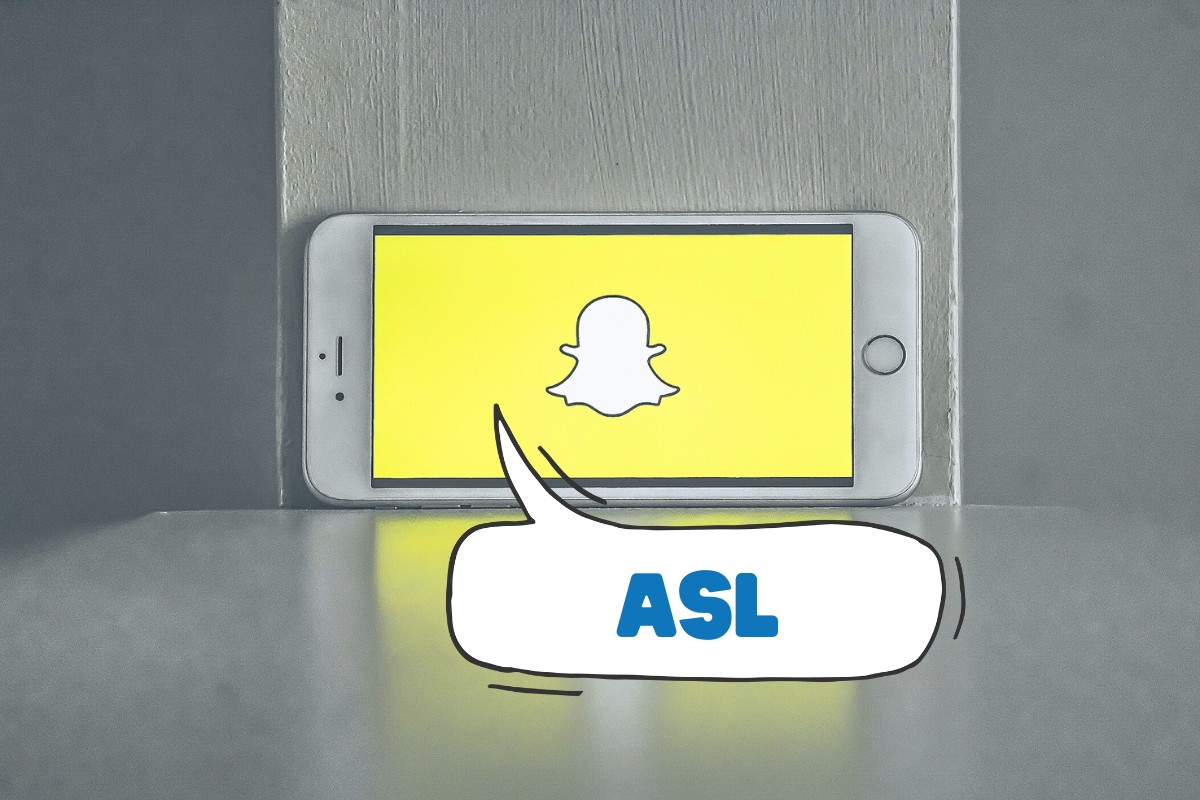Are you new to Snapchat and wondering what does ASL mean on Snapchat?
You’re not alone!
ASL is a commonly used acronym on Snapchat that may leave you scratching your head if you’re not familiar with it.
In short, ASL stands for “age, sex, location” and is typically used as a way to ask someone for their basic information.
If you’re not familiar with the term, seeing “ASL” in a Snapchat message or on someone’s profile may be confusing.
However, once you understand what it means, you’ll be able to navigate the app with ease.
Whether you’re using Snapchat to connect with friends or potential romantic interests, knowing what ASL means is an important part of understanding the language of the app.
Post Contents
- 1 What Does ASL Mean on Snapchat?
- 2 ASL: Age, Sex, Location
- 3 ASL: American Sign Language
- 4 Snapchat and Other Social Media Platforms
- 5 Understanding Snapchat Slang
- 6 Snapchat and Accessibility
- 7 Snapchat on Different Platforms
- 8 Emojis and Acronyms on Snapchat
- 9 Augmented Reality and Snapchat
- 10 Key Takeaways
What Does ASL Mean on Snapchat?

When chatting with friends or making new connections on Snapchat, it’s common to come across the abbreviation ASL.
ASL stands for Age, Sex, Location and is often used as a conversation starter to get to know someone better.
If you’re new to Snapchat or unfamiliar with the term, it’s important to understand that ASL is part of Snapchat slang.
It’s used in casual conversations and is not considered formal language.
When someone asks for your ASL on Snapchat, they’re simply asking for your age, gender, and location.
It’s a quick way to get basic information about the person you’re chatting with.
It’s important to note that ASL is not the same as American Sign Language, which is a language used by the deaf and hard of hearing community.
However, Snapchat has created a tool called ASL Alphabet, which allows users to learn American Sign Language through the app.
ASL: Age, Sex, Location
When you’re chatting with someone on Snapchat, you might come across the acronym ASL.
This stands for Age, Sex, Location.
It’s a common question that people ask when they want to get to know someone better.
ASL is often used by strangers who are chatting online.
It’s a way to find out basic information about the person you’re talking to.
However, it’s important to remember that you should never give out personal information like your address or specific location.
Here’s a breakdown of what each letter in ASL means:
- Age: This refers to how old you are. It’s a basic question that people ask to get an idea of your life experience.
- Sex: This refers to your gender. It’s a common question that people ask to get an idea of who they’re talking to.
- Location: This refers to where you are. It’s a basic question that people ask to get an idea of where you’re from.
When someone asks you ASL, they’re usually trying to start a conversation.
It’s a way to break the ice and get to know someone better.
However, it’s important to remember that you don’t have to answer if you don’t feel comfortable.
It’s also important to remember that not everyone who asks you ASL has good intentions.
Some people use this question to try and take advantage of others.
Always be cautious when chatting with strangers online and never reveal too much personal information.
ASL: American Sign Language
American Sign Language (ASL) is a visual language used by the Deaf and hard of hearing community in the United States and Canada.
It is a complete language with its own grammar and syntax, and it is not based on English.
ASL uses hand gestures, facial expressions, and body language to convey meaning.
ASL is an essential tool for communication within the Deaf community, as it bridges the communication gap between the Deaf and hearing individuals.
It is also a valuable language to learn for those who want to work with the Deaf community or have a Deaf family member or friend.
The ASL alphabet is a system of finger spelling that allows individuals to spell out words and names letter by letter.
It is a useful tool for communication when a sign for a specific word is not known.
The ASL alphabet is also used to teach Deaf children how to read and write in English.
International Week of the Deaf is a week-long celebration of Deaf culture and community that takes place every year in September.
It is an opportunity for Deaf individuals to come together and celebrate their language and culture.
The Deafengers are a team of Deaf engineers who have developed a new Snapchat feature called ASL Alphabet.
This feature aims to bridge the communication gap between the Deaf and hearing communities by teaching users how to finger spell their names and other words in ASL.
Learning ASL is an excellent way to become more inclusive and improve communication with the Deaf and hard of hearing community.
With the ASL alphabet and other resources available, it is easier than ever to learn this valuable language.
Snapchat and Other Social Media Platforms

When it comes to social media, Snapchat is just one of many platforms that people use to connect with others.
Other popular social media platforms include Instagram and TikTok.
Each platform has its own unique features and culture, but they all share the goal of bringing people together online.
Snapchat is known for its focus on ephemeral content, with messages and stories disappearing after a set amount of time.
This can make it a fun and low-pressure way to connect with others, as you don’t have to worry as much about curating a perfect profile or worrying about your content being permanent.
Instagram, on the other hand, is all about creating a visually stunning profile.
Users can share photos and videos that showcase their lives and interests, and can follow others to stay up to date on their own lives.
Instagram also has a strong focus on hashtags, which can be used to discover new content and connect with others who share similar interests.
TikTok is a newer platform that has quickly gained popularity, especially among younger users.
It’s known for its short-form videos, often set to music or other audio.
Users can create their own videos and share them with others, or browse through a curated feed of content based on their interests.
No matter which platform you use, it’s important to remember that social media can be both a fun and a challenging place.
It’s easy to get caught up in comparing yourself to others or feeling like you need to present a perfect image of yourself online.
However, it’s important to remember that everyone has their own unique journey, and that social media is just one small part of it.
Understanding Snapchat Slang
Snapchat is a popular social media app that has its own lingo.
If you’re new to Snapchat, some of the slang terms can be confusing.
Here’s a breakdown of some of the most common Snapchat slang terms:
- ASL: This stands for “Age, Sex, Location” and is often used when getting to know someone on Snapchat.
- S/SU: “Streaks” or “Snapstreaks” refer to when you and a friend send each other snaps (pictures or videos) every day for consecutive days.
- ION: “In Other News” is a way to change the subject or introduce a new topic in a conversation.
- AR: “Augmented Reality” refers to Snapchat’s filters and lenses that use technology to add animations or effects to your snaps.
- STA: “Snapchat to Add” is used when someone wants to add you as a friend on Snapchat.
- ILY: “I Love You” is a common abbreviation used in text messages and on Snapchat.
- FT: “FaceTime” is used to refer to a video call on Snapchat.
- STE: “Short-Term Engagement” refers to when someone only engages with your content for a short period of time.
- DEAF: “Deaf” refers to someone who is hard of hearing or completely deaf. Snapchat has features that make the app more accessible for those who are deaf or hard of hearing.
- GAME: Snapchat has a variety of games that users can play with their friends on the app.
- TECH: “Technology” refers to the advancements and innovations that make Snapchat possible.
- PU: “Pick Up” is used when someone wants to start a conversation or pick up where they left off.
- NGL: “Not Gonna Lie” is used when someone wants to be honest about something.
- SB: “Snapback” is used when someone replies to a snap that was sent to them.
- WR: “What’s Right” is used when someone wants to know what’s going on in someone’s life.
- FISH: “First In, Still Here” refers to someone who was one of the first people to add someone on Snapchat and is still friends with them.
- AMOS: “Add Me On Snapchat” is used when someone wants to add someone else as a friend on Snapchat.
- BRB: “Be Right Back” is used when someone needs to step away from the conversation for a moment.
- FFF: “Follow For Follow” is used when someone wants to exchange follows on Snapchat.
- HMU: “Hit Me Up” is used when someone wants to hang out or talk.
- LMS: “Like My Snap” is used when someone wants their friends to like their snap.
- NR/NRS: “No Response/No Response Snap” is used when someone doesn’t respond to a snap or message.
Knowing these terms can help you navigate Snapchat and communicate more effectively with your friends.
Snapchat and Accessibility
Snapchat is a popular social media platform that allows you to share photos and videos with your friends.
While it is primarily a visual platform, Snapchat has made some strides in improving accessibility for users who are deaf or hard of hearing.
One of the ways Snapchat has improved accessibility is by adding captions and subtitles to video Snaps.
This feature allows users to add text to their videos, making it easier for deaf or hard of hearing users to understand what is being said.
Snapchat has also created a tool to help users learn American Sign Language (ASL).
The tool, called ASL Alphabet, was created by a team of deaf engineers known as the “Deafengers”.
ASL Alphabet teaches users the ASL alphabet through short videos and quizzes.
In addition to ASL Alphabet, Snapchat has also released new lenses and stickers that feature Bitmojis using ASL.
These features add a sense of representation within the app’s many filters, games, and chat features.
For parents and kids, Snapchat’s accessibility features can be a great way to learn and practice ASL together.
Snapchat’s ASL Alphabet tool and ASL lenses and stickers can be used to teach kids the basics of ASL and help them become more comfortable communicating with deaf or hard of hearing individuals.
Snapchat on Different Platforms
Snapchat is a popular social media platform that allows you to share messages and pictures instantly.
It is available on both iOS and Android devices, making it accessible to a wide range of users.
Here’s what you need to know about using Snapchat on different platforms:
Snapchat on iOS
Snapchat on iOS devices offers a range of features that allow you to share your experiences with friends and family.
You can take pictures and videos, add filters and lenses, and share them with your friends.
The app also allows you to chat with your friends and send them snaps.
One of the most popular features of Snapchat on iOS is the ability to create and share stories.
You can create a story by taking pictures or videos and adding them to your story.
Your friends can then view your story for 24 hours before it disappears.
Snapchat on Android
Snapchat on Android devices offers similar features to its iOS counterpart.
You can take pictures and videos, add filters and lenses, and share them with your friends.
The app also allows you to chat with your friends and send them snaps.
However, there are some differences between Snapchat on iOS and Android.
For example, Snapchat on Android may not be as smooth as it is on iOS.
This is because Snapchat was originally designed for iOS devices and was later adapted for Android.
Using ASL on Snapchat
ASL on Snapchat means Age, Sex, and Location.
This is one of the abbreviations that helps you get some information about the other user you are having a conversation with, helping you to get to know each other better.
There are many other abbreviations that are used on Snapchat and other social media platforms.
Launched in April 2022, ASL Alphabet is the latest ASL Snapchat Lens.
It’s also the best place to start if you want to learn ASL.
Upon opening the Lens, users choose one of three exercises — including Alphabet, Build Words, and Match Letters.
Emojis and Acronyms on Snapchat
Snapchat is a social media platform that is popular among young people.
It has a unique feature of disappearing messages, which makes it fun and exciting to use.
However, Snapchat also has its own set of emojis and acronyms that can be confusing for new users.
Here are some of the most common emojis and acronyms on Snapchat that you should know about.
Emojis

Snapchat has a wide range of emojis that represent different things.
These emojis appear next to your friend’s name, and their meaning can vary depending on the color and shape of the emoji.
Here are some of the most common Snapchat emojis:
- Yellow Heart: This emoji appears next to your best friend’s name when you have been sending snaps to each other for two consecutive weeks.
- Red Heart: This emoji appears next to your friend’s name when you have been each other’s best friend for two consecutive weeks.
- Fire: This emoji appears next to your friend’s name when you have been sending snaps to each other for three consecutive days.
- Hundred: This emoji appears next to your friend’s name when you have sent 100 snaps to each other.
- Smiling Face: This emoji appears next to your friend’s name when you are each other’s best friend.
Acronyms
Acronyms are another common feature of Snapchat.
They are used to save time and space while chatting with friends.
Here are some of the most common acronyms on Snapchat:
- ASL: This acronym stands for “Age, Sex, Location.” It is used when getting to know someone on Snapchat.
- TBH: This acronym stands for “To Be Honest.” It is often used when asking for someone’s opinion.
- LMK: This acronym stands for “Let Me Know.” It is used when asking someone to inform you about something.
- FT: This acronym stands for “FaceTime.” It is used when asking someone to video chat with you on Snapchat.
Coda
Snapchat’s emojis and acronyms can be confusing at first, but once you get the hang of them, they can make chatting with friends more fun and efficient.
Keep this guide handy to help you navigate the world of Snapchat.
Augmented Reality and Snapchat
Snapchat has always been at the forefront of technology, and their latest partnership with SignAll has made it possible for users to learn American Sign Language (ASL) through augmented reality (AR).
The new ASL Alphabet Learning Lens, called “Sign With Snap,” is a more advanced and educational version of the three AR-powered lenses that Snapchat had already released back in September 2021, during the International Week of the Deaf.
With the new augmented reality-enabled Lens, you can learn how to fingerspell your name, practice the ASL Alphabet, and play games that put your knowledge to the test.
The randomizer fingerspelling game is a fun way to test your skills, where the app will show you a word, and you have to spell it correctly using ASL.
The ASL Alphabet Learning Lens is an excellent tool for anyone who wants to learn ASL or improve their existing skills.
Snapchat’s new ASL Alphabet Learning Lens is not only about learning ASL.
It is also about using augmented reality to help more people communicate online and, of course, expand Snapchat’s audience in the process.
Augmented reality is a technology that overlays digital content on the real world, creating a new and immersive experience for users.
With Snapchat’s AR technology, you can now learn a new language in a fun and interactive way.
Key Takeaways
If you’re new to Snapchat or chatting with others online, you may have come across the acronym ASL.
Here are a few key takeaways to help you understand what it means and how to use it appropriately:
- ASL stands for “Age, Sex, Location.” It’s often used as a way to get to know someone better in an online chat or social media setting.
- However, ASL can also stand for “as hell,” which is a way to emphasize something. For example, if someone says “I’m tired asl,” they mean “I’m tired as hell.”
- Snapchat has a feature called ASL Alphabet that can help you learn American Sign Language (ASL) for free. The feature includes exercises like learning the ASL alphabet, building words, and matching letters.
- When using ASL in an online chat, be aware that it can be seen as an invasive question. Some people may not feel comfortable sharing their age, sex, or location with someone they don’t know well.
- If you’re not sure whether to use ASL in a chat, it’s always better to err on the side of caution and avoid it altogether. Stick to more neutral topics of conversation until you get to know the person better.
Overall, ASL can be a useful acronym for getting to know someone better, but it’s important to use it appropriately and be respectful of others’ boundaries.
If you’re interested in learning ASL, Snapchat’s ASL Alphabet feature is a great place to start.






























